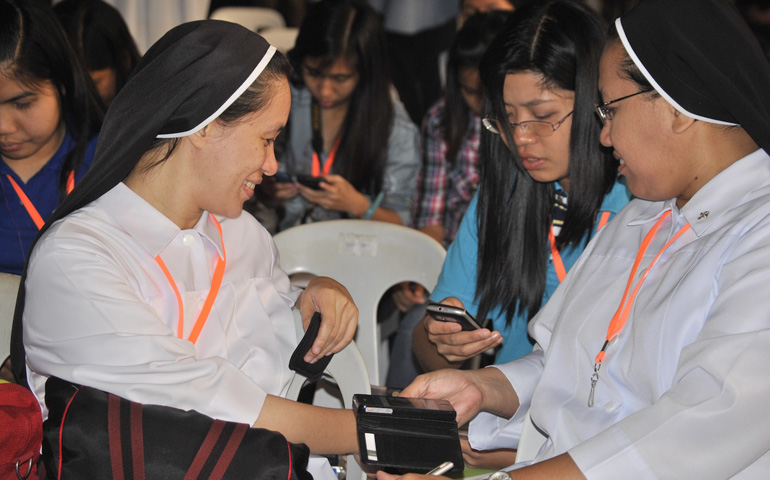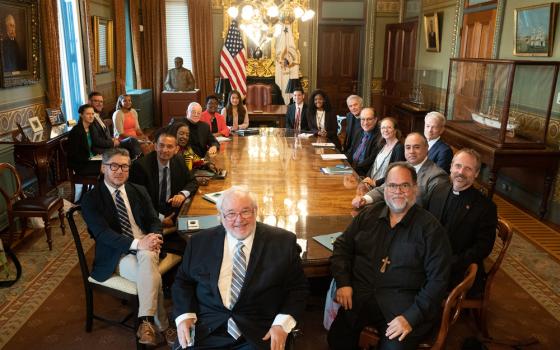
Dominican Sr. Grace Tagnipez, right, tweets for an exercise during the Nov. 23-24 Catholic Social Media Summit at San Juan de Letran College in Manila. (N.J. Viehland)
The man behind Pope Francis' Twitter account, Msgr. Paul Tighe, wants Catholics to use social media to spread the message of Christ's life and the goodwill it inspires in people.
"The most important thing you can do is help to share, post and pass on good positive communications like communications that come from Christ, but also from people of goodwill," Tighe, secretary of the Pontifical Council for Social Communications, told a group of young netizens gathered in Manila for a social media summit Nov. 23-24.
Tighe was the keynote speaker at the summit at San Juan de Letran College, where 400 lay and religious men and women gathered for workshop sessions, prayers and socials organized by the YouthPinoy online community.
Workshops tackled issues on digital transmission of the faith; Internet and minority languages; social media modesty; social entrepreneurship on social media; defending Mary in social media; and strategies to promote the Catholic faith.
Speakers also ran exercises on the "hashtag revolution"; battling the trolls; social media and various forms of activism; YouTube; making modern-day parables; and journalism in 140 characters. The session "Making Disciples of all Netizens" closed the workshop series with a tone of sending off participants on a tweeting mission.
Some discussions and questions focused on Facebook, which reported having 1.11 billion users as of March, 30 million of them reportedly in the Philippines.
Participants also raised questions about Twitter, an online social networking and microblogging service that enables users to send and read tweets, or text messages limited to 140 characters. Last year, the number of Twitter accounts in the Philippines ranked 10th in the world at 10 million.
In December 2012, Pope Benedict XVI launched the papal Twitter account @Pontifex (Latin for "bridge builder") by tweeting from a tablet Tighe used at the Manila summit. Francis continued tweeting at the account after he was elected pope in March.
Acknowledging that Francis cannot engage each of his 10 million Twitter followers, Tighe reminded participants that the presence of the church on the Internet is not just the pope, but all Catholics.
"We can respond to the other people who are responding to the pope's tweet maybe with ... questions, ideas," Tighe said. In doing so, he added, Catholics must use these media in a way that they help people appreciate their faith and build relationships.
He defined "good citizens of social media" as "witnesses, walking with others in the journey of life."
@Pontifex journey
Tighe shared the story of how Benedict brought the church into social media: Tighe's colleagues showed him an iPad where they had loaded pictures. Benedict watched, fascinated, as messages from young people around the world came in through the tablet. Though he did not grow up with social media, Benedict "had the mind and ability to appreciate it," Tighe said.
"But more than that, he also had a vision of how it will help us to communicate the good news of the Gospel," Tighe said. In his view, Benedict was brave to decide to go on Twitter even after he was told there would be negative reaction and people who would say nasty things about him.
"There were some awful comments ... just horrible stuff. I learned new words in every language in the world, and I hope I never get a chance to use them. But you have to work your way through it," Tighe said.
In hindsight, Tighe said, choosing the generic Twitter handle @Pontifex proved to be a wise move.
"There's continuity, which is what @Pontifex is all about," he said. It's not about a cult of a personality; "it's about @Pontifex, which means 'bridge builder,' and that was very much Pope Benedict, who, in his teaching, was always about why the public square, why public debate, why public life had to leave room for faith."
Francis has built on that attitude and "has literally gone out into the public square and made St. Peter's Square, where he's teaching and where he's meeting the public, become almost the great public square of all human debate," Tighe said.
@Pontifex developers had promised every tweet would be approved by the pope and that they would be the pope's tweets, even though he is not physically the one pushing the button. Tighe's team summarizes or extracts ideas from the pope's sermon, speech or message and suggests tweets. Francis approves, changes or nuances it in Italian and Spanish, then the tweet is translated to seven other languages.
"When the pope preaches, he often says something like, 'I want you to remember three words ...' 'I want you to think of three ideas ...' So that makes it easier to have the three key words or whatever the ideas are," Tighe said.
Recurring themes include: "always reach out to people, listen to what people have to say, and then offer them hope, offer them light, offer them Christ," Tighe said.
He acknowledges with guarded appreciation that there has been a more positive mood under Francis, especially among critics of the papacy.
"What people see in him is this yes to life," Tighe said. "So when the pope embraces a severely handicapped person and shows his love and his care for that person, he then can also talk about the need for all of us in society to care for the weak and for the sick with great credibility."
Youth power
Sky Ortigas, the officer in charge of YouthPinoy, said she felt affirmed by Tighe's participation.
"It feels inspiring to see that the big church is with you," she told NCR after the summit.
She said Tighe's message reflected organizers' goals to create a "revolution" through "change coming from ourselves" and uniting Catholics online to serve as missionaries by expressing their genuine persons on social media. Tighe called this "conversion" and "authenticity."
Ortigas noted the energy and enthusiasm of participants at the close of the summit and said she hopes a Facebook group she created under the name OMG (online missionaries of God) on the YouthPinoy account will draw young Catholics who need support in engaging on social media.
"We want people to have the power to be their real selves online because we don't believe there's a virtual and real world, but only the world that God created so you should have integrity and be who you are," Ortigas said.
San Pablo diocese youth commission member Albert Amoguis, a student of aircraft maintenance, has used social media since starting an account with now-redesigned Friendster.
"In CSMS, I learned social media is so powerful when all of us can read and see what others are doing and when posts have the potential to go viral. I learned most from the session on hashtags and defending Mary," Amoguis, 20, said. He said he was impressed by the link drawn between faith and Facebook and said he feels challenged to bring God online by knowing Christ and posting what he says and does, instead of using it solely for self-promotion.
Dominican Sr. Grace Tagnipez said she hopes to apply what she learned to the way she works with her students in Santo Nino Academy in Tarlac, where she serves. "I opened an account on Facebook in 2009 when students were talking about it. I wanted a venue through which I could know how they're doing and to relate with them," Tagnipez said.






